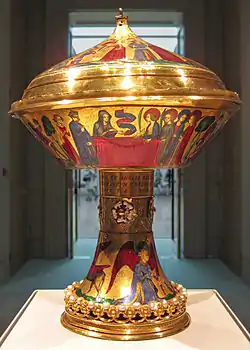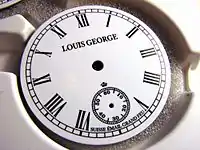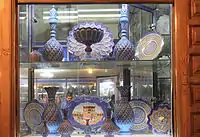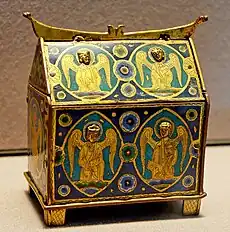Enamel (glass)
Enamel is made of melted glass, often on metal. Sometimes called vitreous or porcelain enamel, it is made by fusing powdered glass to a base by firing, usually between 750 and 850 °C (1,380 and 1,560 °F). The powder melts, flows, and then hardens to a smooth, durable coating on metal, or on glass or ceramics.[1]

The Royal Gold Cup, 23.6 cm high, 17.8 cm across at its widest point; weight 1.935 kg, British Museum. Decorated with enamel and pearls. It was made for the French royal family at the end of the 14th century.
- For other uses of the word, see Enamel
It has been used on decorative objects for two, or three thousand years, but especially in the Middle Ages in Europe. In the 19th century, it was used on everyday objects such as kitchen equipment and road signs. The glass is hard-wearing, scratch resistant and easy to clean.
Gallery
 Silver, silver gilt and painted enamel beaker, Burgundian Netherlands, c. 1425–1450, The Cloisters, nyc
Silver, silver gilt and painted enamel beaker, Burgundian Netherlands, c. 1425–1450, The Cloisters, nyc Limoges? grisaille painted Stations of the Cross, Notre-Dame-des-Champs, Avranches
Limoges? grisaille painted Stations of the Cross, Notre-Dame-des-Champs, Avranches St. Gregory the Great in painted Limoges enamel on a copper plaque, by Jacques I Laudin
St. Gregory the Great in painted Limoges enamel on a copper plaque, by Jacques I Laudin Louis George enamel watch dial
Louis George enamel watch dial Iranian enamel
Iranian enamel

Old German enamel street sign
References
- Chisholm, Hugh, ed. (1911). . Encyclopædia Britannica (11th ed.). Cambridge University Press.
This article is issued from Wikipedia. The text is licensed under Creative Commons - Attribution - Sharealike. Additional terms may apply for the media files.
